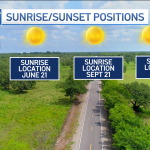Have you noticed the sun is more of a hindrance when driving early in the morning or late in the afternoon on east-west roads?
That's because we have entered sun blindness season. That occurs in September and again in March around the first days of fall and spring.
These are the times of the year when the rising sun is almost directly centered on the eastern horizon. The same thing occurs in the late afternoon as you're driving home from work, the setting sun is directly in your eyes when driving to the west.
This happens in March and September because as the seasons change, so does the sun's position in the sky.
Get DFW local news, weather forecasts and entertainment stories to your inbox. Sign up for NBC DFW newsletters.
Around the equinoxes, fall and autumn, the sun rises around 90 degrees or due east. It sets at 270 degrees or due west. This leaves drivers scrambling for their sunglasses as the glare can be quite blinding on east-west roads.

This is not a problem at other times of the year.
Weather Connection
Connecting you with your forecast and all the things that make North Texas weather unique.
In the summer, the sunrise is in the northeast sky and the sunset is in the northwest. In winter, sunrise is on the southeast horizon and it sets in the southwest. These locations do not have as much of an impact on visibility.
So until we reach mid-October, be prepared for bright sunshine in your eyes when driving on those east-west roads in the early mornings and late afternoons.



